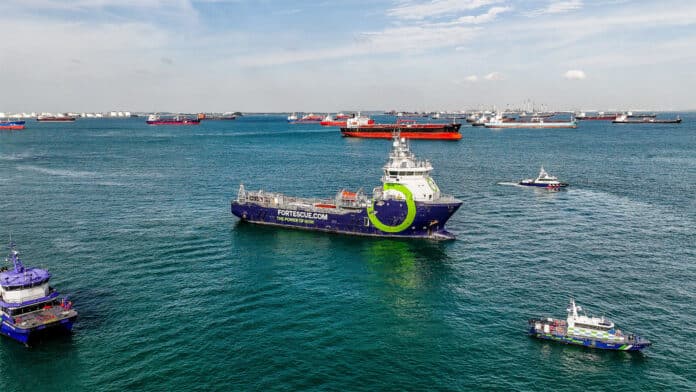In 2021, Australian mining and cleantech company Fortescue announced plans to float the world’s first ammonia-powered ship by 2022. The Green Pioneer is finally ready to set sail.
Fortescue has successfully conducted the world’s first use of ammonia, in combination with diesel in the combustion process, as a marine fuel onboard the Singapore-flagged ammonia-powered vessel, the Fortescue Green Pioneer, in the Port of Singapore.
The Fortescue Green Pioneer was loaded with liquid ammonia from the existing ammonia facility at Vopak Banyan Terminal on Jurong Island for the fuel trial earlier this week. However, it doesn’t appear to have started using the fuel, reflecting the challenges this machine has faced.
Finding a decarbonized shipping solution is crucial, and ammonia is a promising pathway for achieving it. However, it’s a complex process as ammonia can be highly caustic at high concentrations and can pose a significant hazard to humans. Moreover, a fuel tank containing ammonia spills into the ocean can have severe environmental consequences. Despite these challenges, ammonia’s ability to store hydrogen better than hydrogen itself makes it a promising option to explore further.
The Fortescue Green Pioneer is on its way to becoming the first ocean-going ammonia-powered vessel in the world. Fortescue successfully converted a four-stroke engine to run on ammonia and diesel at its land-based testing facility in Perth, Western Australia, in 2022.
Following this success, the conversion work started on the vessel at Seatrium’s Benoi yard in July 2023. The work included the installation of the gas fuel delivery system, safety systems, and infrastructure, as well as the successful conversion of two of the vessel’s engines to enable the use of ammonia and diesel in the combustion process to power the vessel. The remaining two engines will operate on conventional fuels when required.
In December 2023, the vessel sailed from Singapore to the Middle East and was showcased at the UN Framework Convention on Climate Change and COP28 in Dubai, United Arab Emirates.
Before the vessel could begin fueling with ammonia, there were various bureaucratic hurdles to overcome. Crew members underwent extensive safety training, and research studies were conducted to evaluate the potential risks associated with fuel transfer.
HAZMAT response plans were also developed and reviewed by multiple government agencies. A team of researchers from different countries collaborated to create a model that simulated the spread and dispersion of an ammonia spill in the event of an accident. Despite the lengthy approval process, the fueling test ultimately received the necessary clearance to proceed.
The two four-stroke retrofitted engines served as a proxy for the commercialization of ammonia-fueled marine engines under development globally. The engines were able to meet the local air quality standard regarding post-combustion nitrogen oxide (NOx) levels. However, further efforts will be undertaken to reduce the amount of pilot fuel used for combustion ignition and nitrous oxide (N2O) emissions post-combustion as more ammonia-fueled marine engines and low-carbon ammonia sources become available.
Vopak supplied five cubic meters (three tonnes) of liquid ammonia for the fuel trial, using its existing infrastructure at the Vopak Banyan Terminal on Jurong Island. To ensure safety, extensive pre-operations, safety checks, and tests were conducted.
The Fortescue Green Pioneer will load a second tranche of three tonnes of liquid ammonia to carry out further tests and trials over the next few weeks. This is the first time Vopak has used its existing infrastructure in Singapore to facilitate ammonia fuel loading, which underscores the potential for terminals globally to use similar ammonia infrastructure to support the commercialization, operationalization, and progressive scale-up of ammonia as a marine fuel for international shipping.
“Australia and Singapore are nations for whom the seas are our lifeblood, and Fortescue has seen firsthand the willingness of Singapore to lead the world in taking brave, innovative action to build green ammonia shipping,” said Dr Andrew Forrest AO, Chairman of Fortescue. “My message to the Singaporean Government is only green is green. Anything else is made from fossil fuels.”
“The Fortescue Green Pioneer is proof that safe, technical solutions for ammonia power engines exist. But as I did at COP 28 in Dubai, I am once again calling on the world’s ports to get on with setting fair, safe, and stringent fuel standards for green ammonia and not shy away from their responsibilities simply because of a lack of character. We must push to see global emitters paying fair carbon prices for heavy fuels used in traditional shipping. These prices must provide clear investment signals to drive green investment.”
